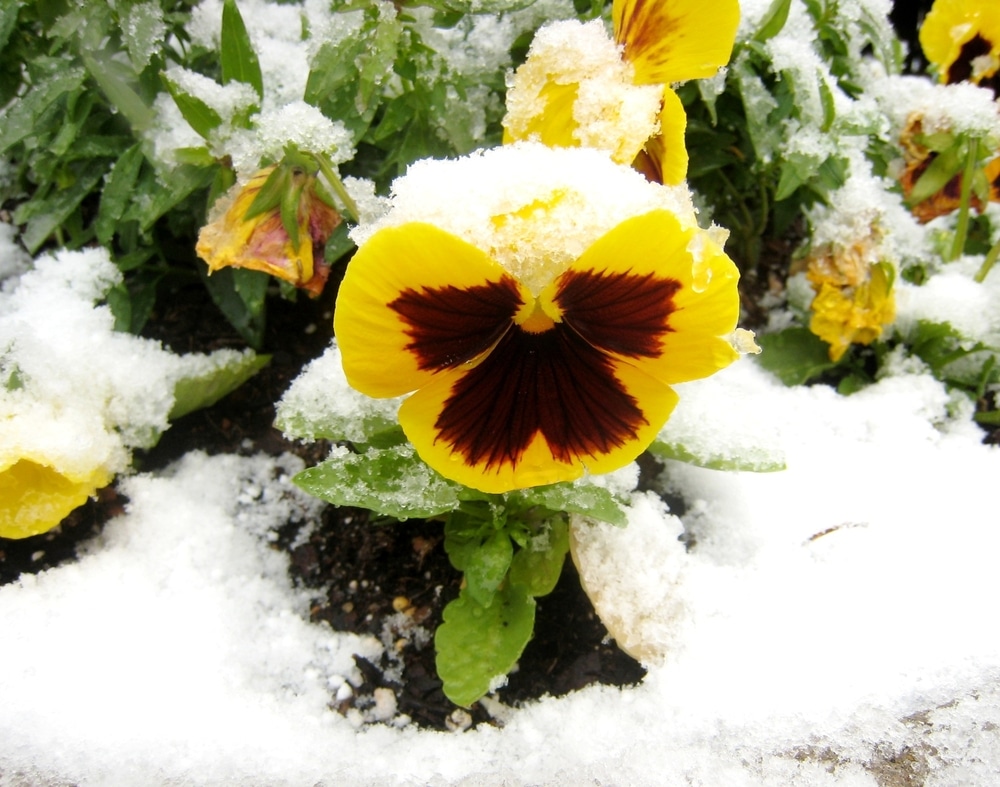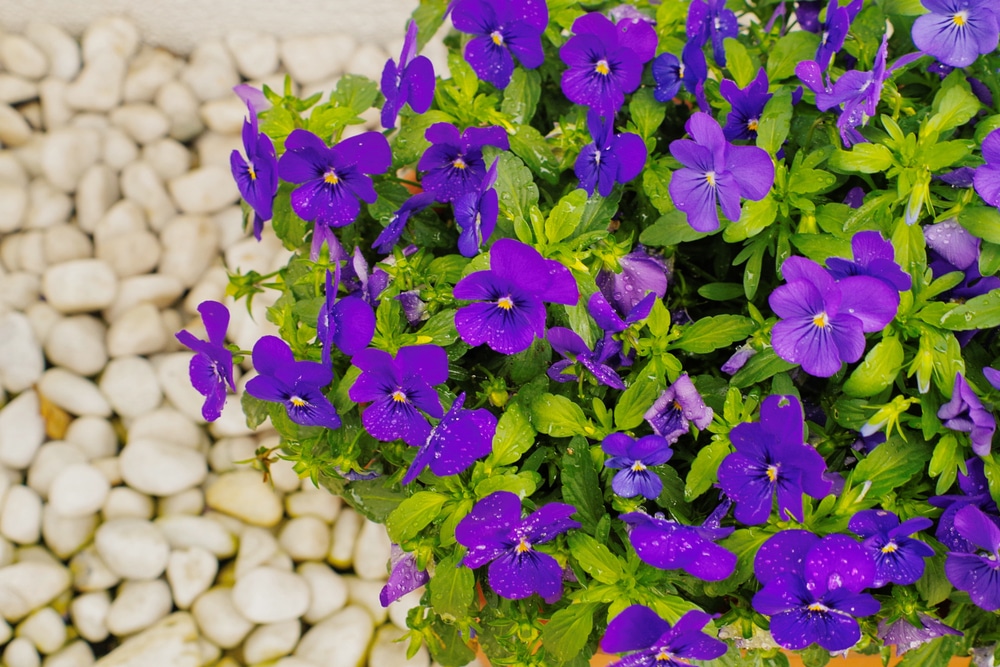In the dark and dreary days of winter, a cheerful burst of color is a welcome sight. Winter pansies to the rescue!
Pansies – Viola x wittrockiana – are members of the viola family. Their relatives include violets, Johnny Jump Ups, and heartsease. They are native to Europe and western Asia and are the result of a hybridization of several flowers in the viola family. Their name comes from the French word, pensée, which means thought.
They grow beautiful, large, colorful flowers. Their flowers may be yellow, purple, white, red, blue, orange, or purple; oftentimes it can even be a mix of multiple colors. Their flowers grow to be about 2-3 inches in diameter and consist of two upper petals, two side petals, and a single bottom petal. The plant itself grows to be about 9 inches high and wide.
As a flowering plant, they are surprisingly tolerant of the cold temperatures of the winter season. As you know, winter is known for empty branches, dormant grass, and sparse vegetation. There are not too many flowering plants that can survive snow and cold winds, but pansies definitely ranks high as one of the few that can. In the dead of winter, these flowers will add a burst of color into an otherwise gloomy and cold season.
If you like flowers, you’ll want to check out our guide on raising plumerias, which are a type of tropical flower tree.

What Are They?
Winter pansies are not a separate species from spring or fall pansies. The name simply indicates their planting and bloom time. Over the years, pansy breeders have developed varieties that are incredibly tolerant of cold weather and adverse conditions.
These tough little charmers can take temperatures to 25°F (-4°C) and will even bloom in winter snow and cold. A hard freeze will kill the flowers and foliage, but the roots can survive and they will grow again when the temperatures warm up.
In hardiness zones 6 through 9, they are planted in the fall for beautiful color all winter long and continued bloom into the spring.

Different Varieties
Listed below is a guide to the different varieties. The varieties that grow best in your region should be available at the garden center.
Cool Wave – Zones 4 to 8
The Cool Wave series is an excellent choice for flower beds. Spreading 24 to 30 inches, these pansies have great overwintering capabilities and the best cold tolerance. They come in a wide array of beautiful flower colors.
Matrix – Zones 6 and Higher
Matrix is a very robust series with large flowers available in clear and blotch forms. Often sold in mixes, Matrix varieties are compact with short stems and resist stretching and floppiness. They have many uses – beds, containers, and window boxes.

Majestic Giants – zones 6a – 8b
Majestic Giants are very popular and boast extra large blooms with contrasting faces. They are very cold hardy and will take some shade.
Colossus – zones 7 to 10
Colossus flowers grow almost 4 inches across, making these beauties a real show stopper. Sometimes, they are so large that you can’t even see the leaves under all the flowers!
Crown – zones 7 to 10
Crown is a series with clear-faced flowers that get 3 inches across. Strong thick leaves and stems make these a good choice for the garden.
Delta – zones 7 to 10
Delta and Delta Premium are very consistent in their flower size and flowering time. They are a great for garden beds.
Heat Elite – zones 8 to 11
Heat Elite is the best choice for warmer climates. They are compact and have short stems and large flowers. They bloom freely, even if grown in the shade. Heat Elite will also keep blooming into the summer in cooler climates.

You might also be interested in our article about popular abelia varieties to consider growing in your garden.
Planting From Seed
Sow pansy seeds when air temperatures are between 65° to 75° F (18° to 23°C). Sow your seeds in September and take care to keep the seeds moist until germination. It may take 10 to 20 long days to see the seedlings germinate. Alternatively, you can start them indoors and transplant the young plants in the garden in September or October.
They can be tricky to start from seed; many people find it’s easier to buy fully grown and blooming plants at the garden center.
Planting From Transplants
When shopping at the garden center, get the largest plants you can afford. Plants in four-inch pots will adapt much more quickly than smaller ones that are growing in cell packs. Once cold weather arrives, pansy growth slows or even shuts down completely, so you’ll be glad you bought larger plants. In gardens, space them 8 to 12 inches apart. In pots, hanging baskets, and window boxes, they can be planted closer together for a fuller look.

Plant when the soil temperature is between 45° and 65° F (7°-18°C). Below 45°F (7° C), pansies go dormant. Above 75° (°C), they wilt in the heat and stop flowering. Grow them in a well-draining soil. They hate having wet feet and are susceptible to root rot.
If you are growing from seed, you can expect blooms in just a few weeks after the plants have developed. They will flower continuously, and blooms can last for months, as the plant will keep developing new flowers, especially if you are good about deadheading.
Gardening Ideas
Plant them in your garden, containers, and window boxes with other cool-season annuals like snapdragons, dianthus, and nemesia. They go well with ornamental kale and with smaller ornamental grasses, like black mondo grass or juncus. They also look good with dusty miller, ferns, and heuchera. And mixing them with their smaller cousin viola can be incredibly charming.
Care Guide
Pansies require very little care. Full sun, adequate water, occasional fertilizer, and frequent deadheading are all they want.
Watering
Water when the top one inch of soil is dry. They will need approximately one inch of water per week if planted in a garden bed.
Check your containers every few days and when they are dry, give your plants a good watering. They can suffer from rot if they are kept too wet. Drier conditions can also help them tolerate cold and frost better.
However, if a cold snap is predicted, be sure they are well watered. Going into a freeze when dry can prevent them from recovering when it’s warm again.

Fertilizing
Fertilize your plants monthly with a balanced liquid fertilizer such as one with an NPK ratio of 10:10:10. Plants in containers may need fertilizer more often – every other week. A slow-release fertilizer can be used at planting time and again in early spring.
Deadheading
Deadheading (the process of removing flowers that have finished blooming) encourages pansies to keep producing their many beautiful flowers. Simply pinch at the base of the flower stem, or you can use scissors or garden clippers. Deadheading will also help keep the plant neat and compact, preventing it from becoming leggy.
Insects and Diseases
Pansies are not frequently the host of insects or diseases. The typical insects — aphids, spider mites, snails, and slugs — might find them tasty, but these pests usually aren’t active in winter. The leaves could yellow due to a too wet soil, indicating rotting roots, or from a lack of fertilizer.

FAQ
What month do you plant winter pansies?
It depends on your location. Pansies droop and wilt and will stop blooming in hot weather, so wait until the summer season is completely over and cooler weather prevails.
Here’s a handy guide:
Zones 6b to 7a — late September
Zone 7b — early October
Zone 8a to 8b — late October
Zone 9 — November
Zones 10 to 11 — late November and December. Use as annuals and grow in partial shade. Replace them with more heat-tolerant garden plants in the spring.
In hardiness zones 4, 5, and 6a, pansies are grown as annuals for spring and fall color. Their roots might survive the winter if planted in the fall, but it’s best to assume they probably won’t come back in the spring. Mulching the garden bed can increase your chances of repeat flowering.

What temperature do they like?
The ideal nighttime temperatures are around 40° (°C), and daytime temperatures are around 60° (15°C).
How long do they last?
When planted in the fall, flowers can last a long time! They can keep blooming until April or May. Depending on the severity of your weather, they can bloom throughout the fall, winter and spring and only start to fade away when summer heat begins. That’s an eight-month growing season!
Can pansies survive a frost?
Pansies can bounce back quickly after a frost. If frost or a freeze is predicted, water the soil well a day or two before. When the they are well hydrated, they can better withstand the cold. Yellow, blue, purple, and white pansies are more cold-hardy than red, rose, orange, or bronze ones.

What temperature will kill them?
They can take cold winter weather down to 25°F (-4°C). Sadly, colder than that may mean the end of your plants. In very cold climates, mulching around your pansy can help them survive through the winter.
If you live in a location with very cold winters, consider keeping your plants warm by bringing them inside for the winters.
Will they come back next year?
They are not perennial, so they won’t return year after year. Their roots can survive very cold weather and the plants can send up new growth in spring. You may also find that your plants will reseed, giving you many happy-faced volunteers for years to come.

